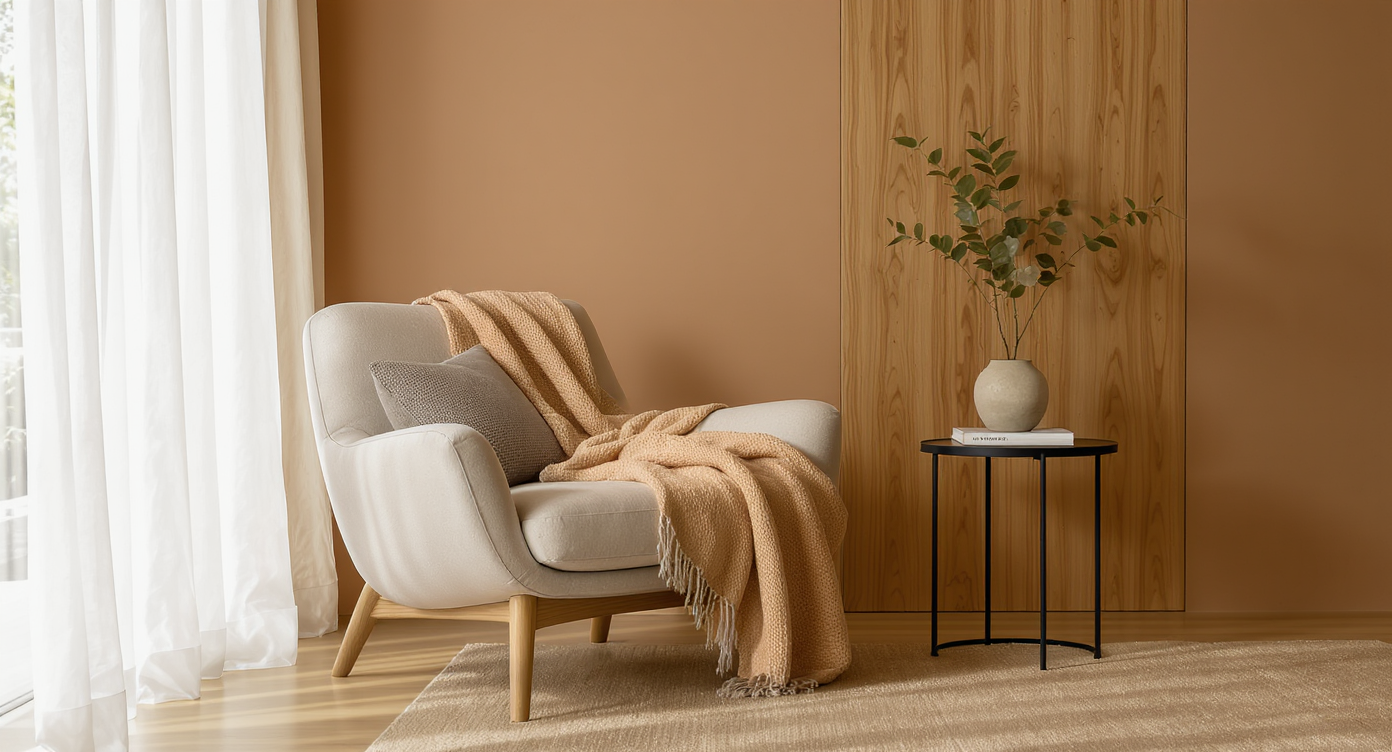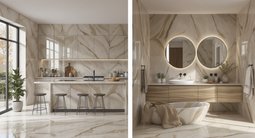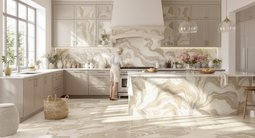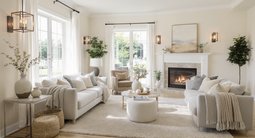TL;DR
Organic modern design in 2025 blends warm neutral palettes, white oak, real plants, and black accents for grounded, livable calm. Expect low-slung storage, sculptural lighting, and tactile finishes that invite touch. If you’re wondering how to design an organic modern living room, think 70% soft neutrals, 20% natural textures, 10% dark contrast.
Why Organic Modern Still Matters in 2025

An organic modern reading nook highlights warm neutrals and natural materials for relaxed comfort.
This year’s organic modern interiors are less about perfection and more about presence. Short-tail keywords like organic modern, warm neutral palette, and white oak floors anchor a look that feels quietly luxurious without shouting for attention. Black accents act as punctuation — never loud, always intentional. Here’s the thing: people are tired of spaces that photograph well but don’t live well. Designers say comfort-led minimalism is the new status symbol, with breathable layouts, matte finishes, and sensory materials replacing high-gloss everything. The long-tail search many of us type — how to design an organic modern living room — is really about building rooms that lower your shoulders the minute you walk in. Across budgets, the movement favors honest materials and simple shapes that age beautifully. Think unstained white oak, natural stone, linen, clay hues, and greenery that earns the spotlight. It’s curated, but it’s not precious.
Trend Overview: Tactile Calm, Honest Materials
Organic modern style marries natural materials, softened geometry, and clean lines for a look that’s minimal yet warm. Experts recommend a 70-20-10 formula: 70% warm neutrals, 20% wood and woven texture, 10% black accents to ground the room. Three ideas unify the trend: tactility, restraint, and nature. You’ll see white oak shelves and floors, limewash or plaster-style walls for soft depth, sculptural lighting, and a few well-sized plants. Designers often advise repeating one wood species across rooms to create visual flow, then using matte black metal or oil-rubbed bronze as contrast. The result is calm, cohesive, and deeply livable.
Anecdote
A homeowner told me they built a low, black media cabinet to stretch a long wall; it instantly fixed the “TV too high” feeling and made space for books and a trailing pothos. Another swapped a too-small bedroom rug for an 8×10 and said the room felt twice as calm — proof that scale is a serenity tool.
The 2025 Organic Modern Design Trends
Warm Neutrals with Black Accents: Organic Modern Palette
Designers often advise balancing a warm neutral palette with 5–10% true black accents to prevent a beige-on-beige look. The 70-20-10 ratio (neutral, natural texture, black) is a reliable rule of thumb for color and materials.
Organic modern color isn’t bland; it’s layered. Creams, oatmeal, putty, and taupe get their shape from black window frames, a dark media cabinet, or charcoal linen. That small dose of contrast sharpens edges the way eyeliner frames the eye. In living rooms, swap a light wood coffee table for a blackened oak or metal base to anchor the seating. In dining zones, a black pendant over a white oak table clarifies the composition. Experts say matte finishes read softer than gloss and hide fingerprints better — aim for 5–10% sheen on wood and walls.
How to Bring It Home
- Keep wall paint warm but complex (think soft greige like “White Duck” or equivalent) and pair with black metal hardware.
- Limit yourself to three wood tones max for cohesion.
- Alt-text caption idea: warm neutral living room with black cabinet and white oak floors.
White Oak Everywhere: Floors, Shelves, and Built-Ins
White oak in 5–7 inch planks is the go-to wood species for organic modern spaces because its grain is subtle and its tone stays neutral. Designers note that repeating one species on floors, shelves, and trim creates instant calm.
From floating shelves flanking a fireplace to slab cabinet fronts, white oak takes stain gracefully — but many favor a light or natural finish that won’t yellow. If you love serene continuity, align shelf thickness with stair treads or tabletop thickness (1–1.5 inches) for a tailored look. A low-sheen finish keeps glare down and texture forward. In open-plan homes, carrying the same oak tone through the kitchen, living, and office reads intentional without feeling matchy-matchy.
How to Bring It Home
- Choose 5–7 inch boards for floors; wider planks feel quieter and minimize seams.
- Match shelf thicknesses across rooms for visual rhythm.
- Use a light white oak stain or waterborne finish to maintain a neutral cast.
Low-Slung Storage and Better TV Height
The most livable organic modern rooms use low consoles or built-ins that keep sightlines open and set the TV at comfortable eye level. Experts recommend a TV center around 42 inches from the floor for living rooms when seated.
I’ve seen this play out again and again: a custom or DIY media cabinet, kept low and long, instantly corrects proportions and reduces visual clutter. In bedrooms, aim for the TV center at 36–42 inches from the floor, or tilt downward so the viewing angle doesn’t exceed 15 degrees. For seating distance, use 1.2–1.6 times the screen diagonal (a 65-inch TV sits comfortably 6.5–8.5 feet away). The bonus of a low piece? It doubles as a display ledge for sculptural ceramics and a trailing pothos — quintessential organic modern decor.
How to Bring It Home
- Float the console 6–8 inches off the floor to lighten the look and simplify cleaning.
- Run cord management inside the cabinet; hide routers in ventilated sections.
- Choose handles in blackened metal to echo window frames or lighting.
Biophilic Layers: Plants, Light, and a Reading Nook
Real plants, generous daylight, and a soft spot to land are core to the organic modern aesthetic. A chair-and-ottoman reading nook thrives by a large window with at least 36 inches of clearance behind for flow.
Think low-maintenance heroes like snake plant, ZZ, rubber plant, and pothos for sculptural volume. The trick many plant lovers use: water only when the top 1–2 inches of soil are dry; most common species prefer that rhythm. Frame windows with long linen panels hung near the ceiling to stretch height — mount rods 4–6 inches above the trim, or just below the ceiling for drama. A small table, warm throw, and dimmable floor lamp are the finishing touches.
How to Bring It Home
- Place the side table 12–18 inches from the chair arm for easy reach.
- Layer a jute rug under a wool blend for texture without visual bulk.
- Alt-text caption idea: window-side reading nook with linen drapery and tall rubber plant.
Sculptural Lighting and Soft Geometry
Sculptural pendants and rounded silhouettes replace sharp minimalism, signaling comfort-led modernism. Designers often advise at least one curvilinear element per zone to soften rectilinear rooms.
Paper or linen shades, plaster-look sconces, and globe fixtures add glow without glare, while curved sofas and drum side tables introduce friendly edges. For kitchen islands, a pair of pendants looks balanced when spaced at one-third intervals along the island’s length, with the bottom of the shade 30–34 inches above the countertop. The effect is cinematic at night and quietly graphic by day — an organic modern signature.
How to Bring It Home
- Mix one round form with two straight-lined pieces in every vignette.
- Dim to 30% in the evening for a spa-like unwind ritual.
- Pick linen, paper, or frosted glass for diffuse light.
Trend Crossovers & Contrasts
Though each idea stands alone, the patterns tie together: warm neutrals need black for definition, and white oak gets richer when paired with linen and matte metal. Across living room and bedroom design, the mix of natural materials and gentle contrast keeps rooms photogenic yet forgiving. Two big mindsets emerge. First, simplify the envelope — fewer finishes, repeated intentionally — then add tactile depth through textiles and plants. Second, scale matters: larger rugs, broader plank floors, and low-slung storage make spaces feel spacious and grounded. Designers often note that repeating one hero material (like white oak) across zones is the fastest route to cohesion.
What People Often Get Wrong About 2025 Design Trends
- Calling beige a plan: Layer undertones and texture, or your warm neutrals read flat. Add 5–10% black to define edges.
- Mounting the TV too high: Keep the screen center around 42 inches in living rooms and 36–42 inches in bedrooms; tilt if needed.
- Buying a tiny bedroom rug: For a queen bed, an 8×10 is the minimum to ground the room; a 9×12 feels luxurious.
- Short curtains: Hang rods 4–6 inches above the trim (or near the ceiling) and extend 8–12 inches past the window on each side.
- Over-styling shelves with generic objects: Mix books, personal photos, and one-of-a-kind ceramics for soul and scale.
Visualization Scenario
Open ReimagineHome and test a warm greige wall with white oak floors, a long black console, and a sculptural linen pendant. Try a window-side reading nook with ceiling-height drapery and a rubber plant to see how daylight and contrast reshape the room.
FAQs
What is organic modern design?
Organic modern design blends clean lines with natural materials like white oak, stone, linen, and plants, framed by soft black accents. The look is minimal yet warm, with tactile finishes and a warm neutral palette.
How should I design an organic modern living room on a budget?
Use high/low: invest in a solid rug and lighting, then source decor from big-box and handmade marketplaces; add real plants for impact. DIY or semi-custom low media cabinets can deliver the look affordably.
What’s the best TV height for a bedroom?
Aim for the TV center at 36–42 inches from the floor or tilt the screen so the viewing angle is under 15 degrees. Keep the viewing distance at roughly 1.2–1.6 times the diagonal.
What rug size works for a queen bed in an organic modern bedroom?
Designers recommend at least an 8×10 under a queen to ground the bed and nightstands; a 9×12 adds generous walking area. Place the rug so it starts about one-third under the bed.
How do you mix black accents with wood without making the room feel heavy?
Keep black to 5–10% of the scheme and repeat it purposefully in lighting, hardware, or one anchored piece. Pair with white oak or mid-tone woods to maintain balance and warmth.
Living Soft, Not Safe
In 2025, the organic modern trend isn’t a palette; it’s a posture. It asks for clarity over clutter, craft over flash, and materials that feel better the longer you live with them. The rooms that stay with you are simple to read and rich to touch — a linen shade here, a white oak shelf there, a plant that greets the sun every morning. If you’re starting fresh, start small: get the scale right, repeat your favorite wood, and let contrast be your editor. Everything else is nuance. Quietly, that’s the point.
.svg)

.svg)














.png)